The Korea–U.S. Tariff Agreement
The Korea–U.S. Economic Alliance:
Where Do We Go from Here?
On July 31 (KST), Korea and the United States reached a dramatic breakthrough in their trade negotiations, establishing a broad agreement between the two nations. While the uncertainty that had persisted since the launch of President Trump’s second term has been temporarily resolved, trade experts unanimously cautioned that Korea must urgently prepare for the next phase of detailed negotiations. In response, the Federation of Korean Industries (FKI) hosted a roundtable on August 5 titled “The Evolving U.S.–Korea Economic Alliance: From Tariffs to Technology and Industry Partnership”, inviting leading experts from both countries to assess the implications of the agreement and outline strategic next steps.
Compiled by Hye-won Kim
Photographers Dong-yeol Kim, Gyu-cheol Shin
Five Experts Discuss Paths Forward for Bilateral Cooperation
The roundtable featured prominent participants from the U.S., including Jeffrey Schott, Senior Fellow at the Peterson Institute for International Economics, and Patrick Cronin, Chair for Asia-Pacific Security at the Hudson Institute, as well as Korean experts such as Myung-hee Yoo, Professor at the Graduate School of International Studies, Seoul National University; Seok-young Choi, Advisor at Bae, Kim & Lee LLC; and Jae-min Lee, Dean of the School of Law, Seoul National University.
Session I began with welcoming remarks by Chang-beom Kim, Vice Chairman of FKI, followed by presentations from U.S. experts via video conference. Jeffrey Schott expressed hopes that Korea’s recent investment pledges would lead to expanded domestic production in the United States, thereby invigorating bilateral trade. Patrick Cronin noted that Korea’s substantial investment commitments in key industries suggest it will play a vital and capable role as a core U.S. ally going forward.
Session II featured a panel discussion with Chul Chung, Chief Research Officer of FKI and Director of the Korea Economic Research Institute (KERI), alongside leading Korean trade specialists. The panel reviewed the evolving nature of Korea–U.S. economic cooperation and the Korean business community’s strategic response. Experts generally agreed that the overarching deal contributed to calming market volatility and regarded the agreement as a key achievement of the negotiations. They emphasized that public and private sectors must now come together as “Team Korea” to prepare for detailed follow-up negotiations and presented a range of potential strategies.
“This trade agreement is significant in that it renews expectations for the value and potential of the Korea–U.S. economic alliance and cooperation in advanced industries.
The race to find the optimal solutions is still underway.
We must go beyond tariff figures and ensure the alliance evolves into a deeper partnership in technology and industry.”
- Chang-beom Kim, Vice Chairman of FKI
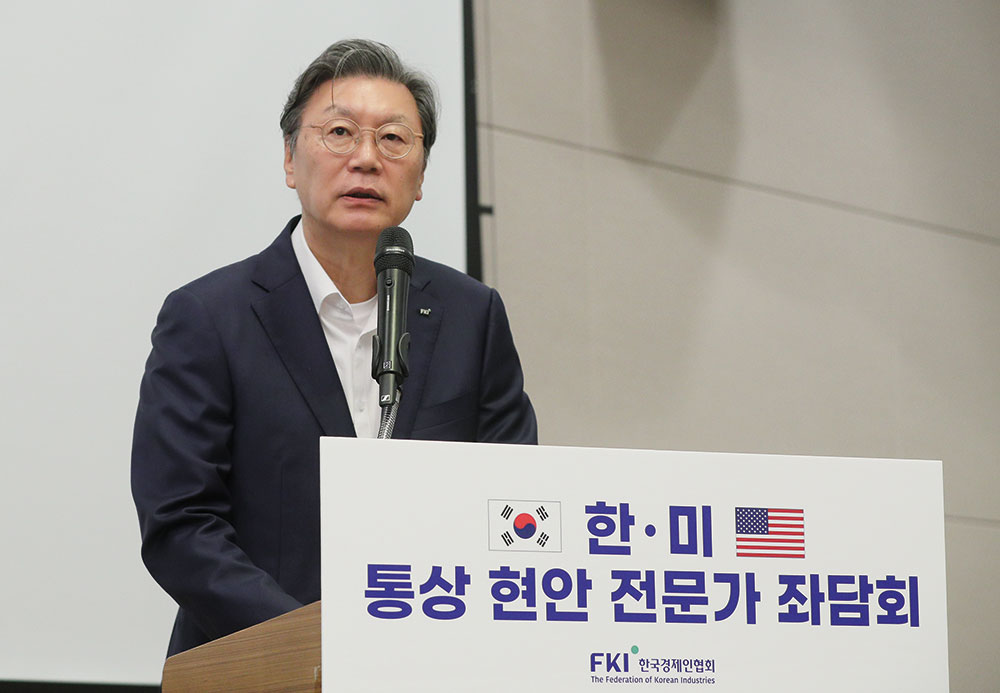
Keynote Presentation
U.S. Assessment and Outlook


Jeffrey J. Schott, Senior Fellow, Peterson Institute for International Economics (PIIE)
“Korea is the only U.S. FTA partner to have concluded a framework agreement, and the outcome is generally seen as favorable compared to those of the E.U. and Japan. However, there remains a possibility that further executive orders could alter the agreement, so Korea must be prepared.”Summary of the Korea–U.S. Trade Negotiations
➊ The recent framework agreement is expected to have a major impact on the auto sector. Korea currently faces a 25% tariff on automobiles, and it is unclear whether this will change. As nearly 70% of Korea’s trade surplus with the U.S. comes from auto exports, further developments should be closely monitored.
➋ Korea plans to invest $350 billion in the U.S., about 40% of which will go to shipbuilding. This is expected to strengthen U.S. shipbuilding capabilities and may also lead to expanded Korea–U.S. cooperation in the defense industry.
➌ Korea has also pledged to purchase $100 billion worth of U.S.-produced LNG and energy, a move with strategic significance for energy security and supply chain resilience.
Key Issues and Considerations
➊ The role of the Korea–U.S. FTA as a foundation for expanded trade should be reexamined. Strengthening partnerships through agreements such as the CPTPP could also help broaden supply chains.
➋ A court case is currently underway regarding the International Emergency Economic Powers Act (IEEPA). While the final ruling may vary, most forecasts expect reciprocal tariffs to remain in place until 2026, underscoring the need for preemptive action.
➌ This agreement should serve as an opportunity to recalibrate Korea’s export strategy to the U.S., with new growth expected in sectors such as shipbuilding and semiconductors through bilateral cooperation.
Q. How would you assess the economic benefits of the Korea–U.S. FTA? What’s next for the alliance? And how can Korea, as APEC chair, contribute to economic integration in the Asia-Pacific?
A. The Korea–U.S. FTA still holds value as both an economic and security safeguard. However, U.S. tariff policies could disrupt this close interdependence. Korea should work to reduce short-term shocks and deepen long-term cooperation particularly in strategic sectors such as shipbuilding, energy, and semiconductors.
As I have emphasized, collaboration with partner countries is more important than ever. As APEC chair, Korea should focus on strengthening ties with CPTPP member states and attracting new participants.

Patrick M. Cronin, Chair for Asia-Pacific Security, Hudson Institute
“Recent signs of decline in major U.S. industries have underscored the importance of industrial self-reliance and alliance-based cooperation. Korea has long been recognized for its technological innovation and its role in reshaping global value chains. It is time to work with trusted allies to strategically integrate industries and drive fundamental change.”Five Key Areas for Strengthening Korea–U.S. Industry Partnerships
➊ Strengthening defense industry partnerships
Cooperation should expand beyond traditional security into integrated defense industry partnerships. To accelerate this shift, the U.S. Department of Defense needs to implement fast-track procedures. Cybersecurity and AI-based command and control systems will emerge as priority areas.
➋ Cooperation in shipbuilding and maritime industries
Korea’s world-class shipbuilding capabilities should be leveraged to boost MRO capacity and enhance marine infrastructure.
➌ Establishing a semiconductor supply chain
Just as the U.S. has partnered with TSMC to strengthen its manufacturing base, it should also work with Korean semiconductor firms to jointly build a secure, full-cycle ecosystem (spanning rare earth element sourcing, processing, design, fabrication, packaging, and testing).
➍ Energy security
The $100 billion Korea–U.S. energy cooperation fund could be used to secure long-term LNG supply contracts and jointly develop small modular reactors (SMRs). Korea’s specialized capabilities in batteries, EVs, and energy storage systems (ESS) could support the strategic energy demands of the AI and digital sectors.
➎ Institutionalized strategic economic cooperation framework
The Korean and U.S. governments should collaborate to establish integrated economic and security governance.
Q. In light of global supply chain realignment and the intersection of economic and security issues, how should the Korean industry respond?
A. China is strategically pursuing greater independence, and the next decade will see intense competition for technological dominance. Countries must reposition accordingly. It’s essential to secure key supply chains and technological capabilities while cooperating with a range of allied nations. This is an inevitable challenge for all countries.
Panel Discussion
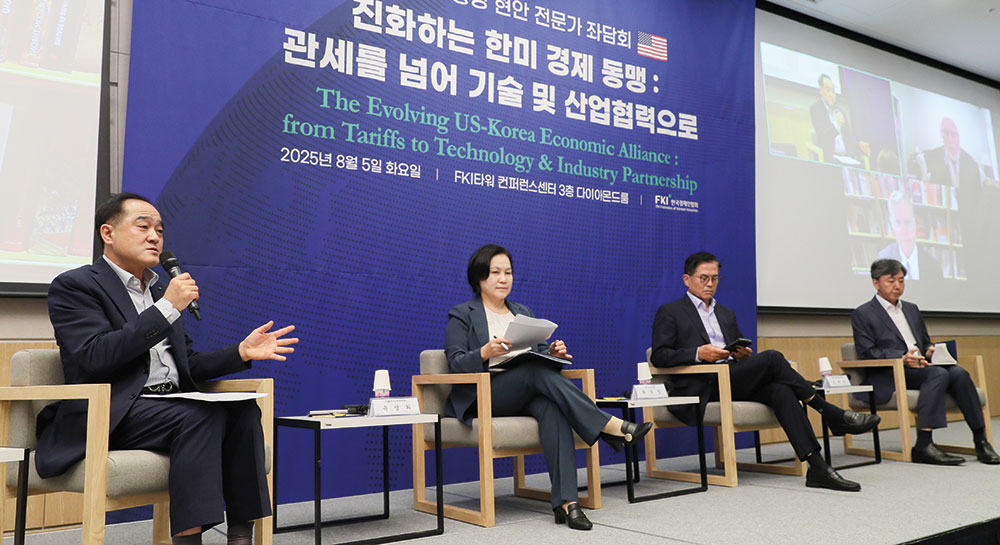
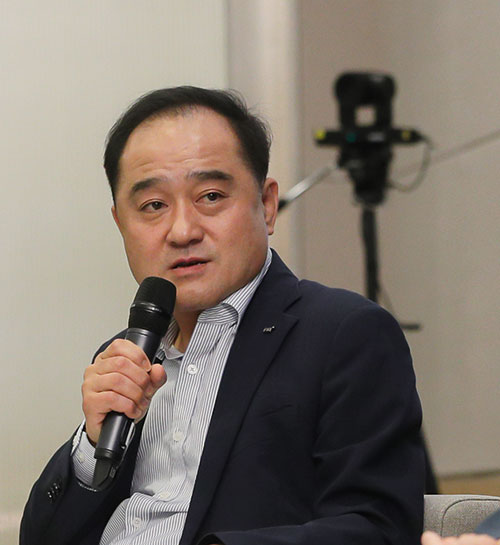
Chul Chung
- Chief Research Officer, FKI;
President, KERI
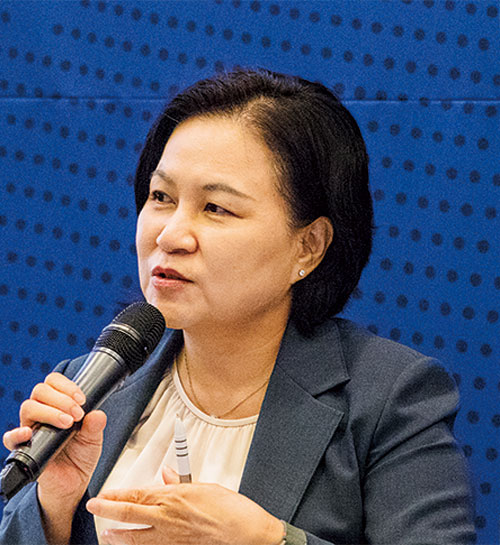
Myung-hee Yoo
- Professor,
Graduate School of International
Studies,
Seoul National University
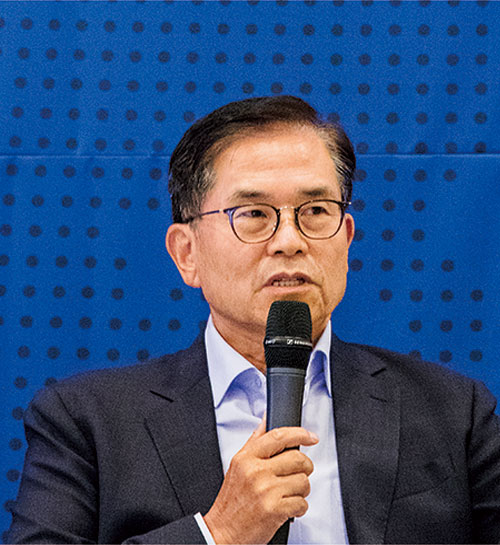
Seok-young Choi
- Senior Advisor, Lee & Ko
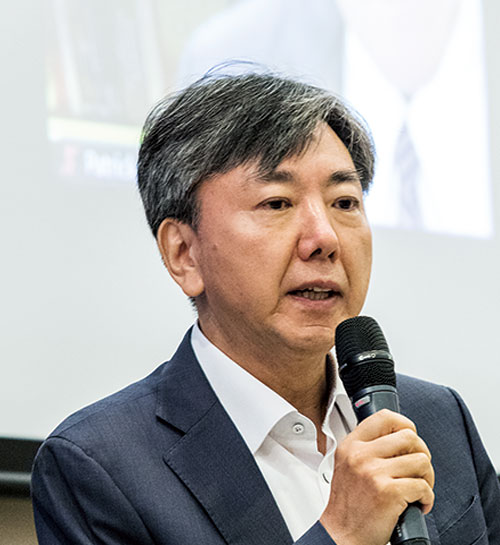
Jae-min Lee
- Dean, School of Law,
Seoul National University
Assessments on the Tariff Agreement
Myung-hee Yoo Despite considerable time pressure, Korea successfully came to an agreement at the right moment. This must be viewed as a solid outcome. We are now entering a period of fundamental transformation that is reshaping global trade systems as a whole. Given such conditions, reducing tariffs below 15% would have been an unrealistic goal. The remaining priority is to determine the operational specifics of the unprecedented investment fund to be jointly established and managed by the two countries.
Seok-young Choi I hold a similar view. While the agreement is meaningful in that it helped avoid the worst-case scenario, some regrets remain, particularly regarding the Korea–U.S. FTA and automotive sector provisions. Going forward, security issues are likely to feature prominently in the next bilateral summit. Though economy, security, and trade may appear as distinct agendas, they are in fact interconnected as a single package. The two nations must begin to articulate concrete ways to generate mutual gains across all three areas.
Jae-min Lee To add to that, it has only been 13 years since the Korea–U.S. FTA was signed, yet the trade environment has changed so rapidly that it feels closer to 130 years. The pace of change is extraordinary, and it is unfortunate that the FTA is increasingly being tested under mounting pressure.
Chul Chung I agree. Nevertheless, Korea still retains valuable strategic assets as a signatory to the FTA. Aside from the tariff-related areas, the agreement remains functional and can still serve as both a negotiation channel and a safeguard mechanism through platforms such as the Joint Committee. Most importantly, it is imperative to enhance the global competitiveness of Korean industries. I invite your insights on how we should proceed in this regard and on the direction of follow-up measures.
Industrial Impact and Policy Challenges
Myung-hee Yoo The Trump administration is actively using tariffs to induce domestic production and consumption. It is time for Korea to devise strategies aligned with this changing trade paradigm. As Korean investments increasingly flow into the United States, concerns are mounting about the hollowing out of Korea’s domestic manufacturing base. To build resilience in any trade environment, we must diversify our negotiation tools beyond the shipbuilding sector. The government should actively support domestic industry by easing regulations and improving labor market flexibility. Another viable option would be to develop joint projects that leverage Korea’s manufacturing strength and the United States’ technological edge, with Korea providing the necessary financial support.
Since non-tariff barriers remain unresolved in the recent agreement, Korea must also pursue upgrades and modernization in that area. In parallel, we must take on key tasks, such as expanding participation in regional trade agreements such as the CPTPP, strengthening communication with domestic stakeholders, and enhancing linkages with Global South economies. The government must serve as a platform for trade diversification efforts.
Jae-min Lee Our ability to make strategic use of shipbuilding and semiconductors stems from Korea’s technological superiority in these sectors. The government must now step in to strengthen technological competitiveness in other core areas. Many non-tariff barriers can be addressed through detailed explanations and systemic reforms. This requires continuous coordination through mechanisms such as the Korea–U.S. Joint Committee and working-level consultations. Regarding the investment chapter of the FTA, which governs a wide scope of assets, including intellectual property and contractual rights, as well as every stage from establishment to exit, it is crucial to define the scope and operational model of such investments in clear terms.
Seok-young Choi Under an executive order issued by the U.S. government on August 1, any violation of country-of-origin rules will, starting August 7, trigger up to 40% in additional tariffs and penalties. Korean firms must now be more meticulous than ever in verifying country-of-origin compliance. This development is directly linked to U.S.–China strategic rivalry, and it is grounded in congressional legislation rather than executive fiat. So, this policy is likely to remain in place regardless of future changes in administration. The key here is diplomatic leverage, and I believe Korea currently possesses the strongest leverage among all negotiating countries. Korea’s industrial competitiveness in shipbuilding, SMRs, defense, semiconductors, batteries, and electric vehicles gives the country a strategic edge. In the face of continued U.S. pressure, macro-level, long-term strategic assessments are essential.
Policy Recommendations and Closing Remarks
Chul Chung Thank you for your insightful contributions. To close, let us offer final recommendations for Korea’s strategy in a rapidly changing global trade landscape.
Jae-min Lee Over the past six months, we have effectively entered a “post-WTO,” “post-FTA” era. It is time to prepare in earnest for a new dimension of public–private cooperation that can guide us through the next 10 to 20 years.
Seok-young Choi With multilateral trade systems faltering and bilateral agreements no longer functioning as intended, we must revise domestic laws and policies to strengthen the international competitiveness of Korean firms.
Myung-hee Yoo U.S. tariffs now average 18% the highest level since 1934 and this high-tariff era is expected to persist for some time. If Korean companies secure irreplaceable technological capabilities and the government provides steadfast support, then Korea will remain resilient in the face of any global trade shifts.
